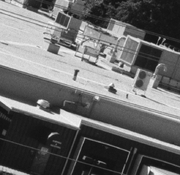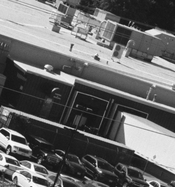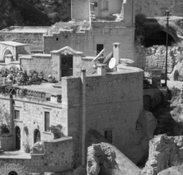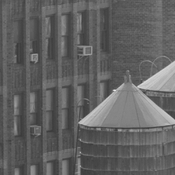I've posted a bit about this in the Copex Rapid Advice thread. Getting the highest resolution out of film is relatively straightforward, if not exactly
easy - use a super-high-res film like CMS 20 or Copex, a very sharp lens, and a tripod. You can avoid the tripod by only shooting in bright sun (on a sunny day, Copex will let you use 1/250 or so at f/5.6) or maybe using an IS lens. But not an IS zoom, because you likely won't get the resolution you need out of it.
Now, is it worth it? Well, who knows? I can offer a bit of context, at least. Here's a shot taken on Copex at f/5.6 with a pretty cheap Rikenon P 50/1.4 on a Pentax ME Super.
This is scan composed of several stitched shots from a 24mp NEX-7. The final version is 12739x8539, coming out to an equivalent of nearly 9000dpi. I think it's around 177lp/mm? Here's a crop from near the center. Bear in mind that at least on my 27" 2k monitor (109ppi), viewing this at 100% equates to an
almost 10-foot print.

Now, this is a 108-megapixel image, but it obviously isn't resolving 108 megapixels of detail. I would say it resolves about as well as a 36mp sensor, depending. Here's what it looks like reduced to 36mp:

And, because why not, a screengrab of what it looks like on my monitor previewing a 30x45 print, which is the largest standard-ratio I could get made at any typical commercial lab:

Whatever else, let's appreciate that it's fully possible to get a very clean, sharp 30x45 print out of 35mm film!
But now...let's put that side-by-side with a similar 30x45 preview from my 24mp original RX1:
The conclusion I can draw right away is that if you don't plan on printing bigger than 30x45, shooting these hi-res films is
probably not worth it
vs. digital, especially if you're aiming for shooting on trips. They're not very convenient to use, thanks to their low ISO and odd developing requirements, and don't (in my opinion) impart any sort of interesting character to an image the way Tri-X or HP5 do. And there are tons and tons of cheap 24mp digital cameras out there that'll give you what you need. And they shoot in color!
It also shows that no, you do not need an $8000 Leica lens to make the most of film resolution. I'm sure the Summicron APO would be marginally better than this (and would likely have improved corners), but I paid less than $100 for the camera and lens combined. Speaking of which, if you're going to be selective about what you shoot, $6 a roll for Copex makes this not a bad bargain vs. the digital option, especially in terms of buy-in cost.
Here's one more comparison set. First, again, is the 100% crop from the 108mp Copex scan, and second is the RX1 image enlarged to the same size (and de-saturated for fairness).


I
hate enlarged digital images, and I'd pretty obviously choose the Copex shot here if I had to pick one of these to print at 10' wide. I would actually hang the 10' print of the film shot on my wall and have no problem with people sticking their faces right up to it! However, when we swap the 24mp RX1 for a 61mp A7RIV (this shot is from DPReview's sample gallery), it's a different story.


I suppose I might still prefer the film shot from a subjective standpoint thanks to the organic nature of the grain, but the digital one is now
technically better. And, again, the original's in color. So if you've got the money for one of the modern 61mp cameras and a lens that can handle it, that's the way you should probably go. Still, at $2400 for, say, a used A7rIV with a Tamron 35/2.8, you could shoot a
lot of Copex before you started losing money in the comparison!












